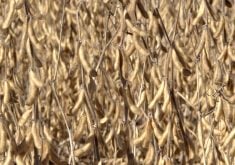Corrected, Sept. 3 — MarketsFarm — Canadian oat prices should remain well supported over the next year given the smaller crop, but some demand will likely back away as buyers look for cheaper alternatives.
While most of his customers were still taking delivery on existing contracts and not yet in the spot market, Ryan McKnight of Linear Grain at Carman, Man. noted Canadian mills and other end-users were already stepping up their pricing.
Oats prices have seen a steady rise over the summer, with bids topping out at $6 per bushel in Manitoba and nearing $5.75 in Saskatchewan.
Read Also

U.S. grains: Soy futures post biggest monthly gain in nearly five years on China trade optimism
U.S. soybean futures climbed to a 15-month high and posted their biggest monthly gain in nearly five years on Friday following a rally fueled by the prospect of revived exports to China.
“The mills will need (oats) but some other non-milling markets will fall away,” McKnight said.
While some feed demand was inelastic, the high prices will limit that buying interest; some feed markets have already been cutting back their purchases.
Yield and quality this year were extremely variable, according to McKnight, and he expected anything that wasn’t super-low on test weight would go for milling.
Canada will have grown 3.07 million tonnes of oats in 2021, which would be down by 33 per cent from the previous year, according to the latest Statistics Canada estimates.
The smaller crop will also likely cause exports to slow down, with some eastern buyers possibly importing oats from Europe to meet their demand, McKnight said.
— Phil Franz-Warkentin reports for MarketsFarm from Winnipeg.
Correction, Sept. 3, 2021: Oat bids reported in the third paragraph are in fact “per bushel,” not “per tonne” as written previously.













